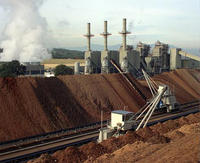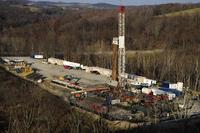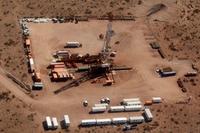-
Producing renewable hydrogen

Hydrogen is regarded as the cleanest and greenest of all fuels; a California company combines its polymer coating with a small-scale solar device to form a self-contained particle that separates hydrogen from water using only the power of the Sun
-
-
New geological insights to aid oil extraction, water recovery
By understanding the variety of pore sizes and spatial patterns in strata, geologists can help achieve more production from underground oil reservoirs and water aquifers; better understanding also means more efficient use of potential underground carbon storage sites, and better evaluations of the possible movement of radionuclides in nuclear waste depositories to determine how well the waste will be isolated
-
-
Collecting solar power in space
Researchers have tested equipment in space which would provide a platform for solar panels to collect the energy and allow it to be transferred back to earth through microwaves or lasers; this method would provide a reliable source of power and could allow valuable energy to be sent to remote areas in the world, providing power to disaster areas or outlying areas that are difficult to reach by traditional means
-
-
Calibrating volume of U.S. petroleum flow
Per capita consumption of petroleum in the United States is ten liters per day; there are 300 million people in the United States, so this means that three billion liters, or about nineteen million barrels, of petroleum are moving around across the United States in pipelines, waterways, roads, and rails each day; with crude oil priced around $100 a barrel, this comes to about $2 billion worth of petroleum
-
-
Biofuel tree offers abundant energy

The Pongamia trees require minimal nitrogen fertilizer, grow fast, show a strong tolerance to drought and salinity, plus they will not compete with prime agricultural land; Aussie researchers plan to plant 3,000 hectares of Pongamia trees in north Queensland, which will yield an estimated ten to fifteen million liters of biofuel
-
-
Waste-to-energy technology deployed in California

A new Anaerobic biodigester waste processor, which relies on bacteria to break down biodegradable waste material in the absence of oxygen, is deployed by a Sacramento, California company; it converts 7.5 tons per day of food waste from regional food producers, including Campbell’s Soup Company, and a half ton each day of unrecyclable corrugated material into natural gas; the system will generate roughly 1,300 kWh of renewable energy per day, meeting about 37 percent of the company’s electricity needs and preventing an estimated 2,900 tons of waste from entering landfills each year
-
-
Safe fracking requires distance from sensitive rock strata
Fracking — the process which releases natural gas and oil from shale rock strata – is becoming more and more popular because it promises access to new, abundant sources of energy; the process of fracking, however, has been associated with increase in the frequency of earthquakes and contamination of drinking water; scientists examine thousands of fracking operations in the United States, Europe, and Africa, and conclude that in order to minimize water contamination and earthquakes, there should be a minimum distance of at least 0.6 km between a fracking operation and sensitive rock strata
-
-
New, vast source for electricity: rivers flowing into the sea
A new type of electric power-generating stations could supply electricity for more than a half billion people by tapping just one-tenth of the global potential of a little-known energy source that exists where rivers flow into the ocean
-
-
Increased U.S earthquakes may be caused by fracking

From 1970 to 2000 the number of magnitude 3.0 or greater temblors in the U.S. mid-continent averaged twenty-one annually; by 2011 the number of such quakes had increased to 134; a new study by the U.S. Geological Survey links the increase of seismic activity to the increase in the use of hydraulic fracturing, or fracking
-
-
Wind power most cost-effective among renewables
Many developing countries should turn to wind power plants because of the lower costs, researchers have concluded in a new study on the use of climate protection funding from the north
-
-
Small modular nuclear reactor may come to South Carolina
The U.S. Department of Energy’s (DOE) recently announced federal award totaling up to $452 million to support engineering, design certification, and licensing for up to two first-of-its kind small modular nuclear reactor (SMR) designs; a South Carolina-based organization dedicated to promoting innovative nuclear power generation wants to bring one such SMR to the state
-
-
Nuclear power stations launches emergency operations center
The new 12,000 square-foot facility at the Beaver Valley Power Station supports overall management of activities related to maintaining public health and safety during the emergency at the plant
-
-
Alternative to Keystone XL pipeline planned

The Obama administration rejected of the Keystone XL pipeline to carry Canadian oil to refineries on the U.S. Gulf coast, and now two companies are collaborating to develop an alternative plan to achieve the same end
-
-
The Transboundary Agreement is not just about the cost of gas and the environment
The Transboundary Agreement, which the United States and Mexico reached on 20 February, regulates oil and gas development in the Gulf of Mexico; before the agreement is ratified, there is a need to address serious security issues related to building more oil rigs in the Gulf – for example, the fact that the Mexican government cannot control its powerful criminal organizations, and that it will be easy for terrorists in a small boat to overrun one of these deepwater rigs
-
-
Electricity from trees
Plants have long been known as the lungs of the earth, but a new finding has found they may also play a role in electrifying the atmosphere; scientists found the positive and negative ion concentrations in the air were twice as high in heavily wooded areas than in open grassy areas, such as parks
-
- All
- Regional
- Water
- Biometrics
- Borders/Immig
- Business
- Cybersecurity
- Detection
- Disasters
- Government
- Infrastructure
- International
- Public health
- Public Safety
- Communication interoperabillity
- Emergency services
- Emergency medical services
- Fire
- First response
- IEDs
- Law Enforcement
- Law Enforcement Technology
- Military technology
- Nonlethal weapons
- Nuclear weapons
- Personal protection equipment
- Police
- Notification /alert systems
- Situational awareness
- Weapons systems
- Sci-Tech
- Sector Reports
- Surveillance
- Transportation
Advertising & Marketing: advertise@newswirepubs.com
Editorial: editor@newswirepubs.com
General: info@newswirepubs.com
2010-2011 © News Wire Publications, LLC News Wire Publications, LLC
220 Old Country Road | Suite 200 | Mineola | New York | 11501
Permissions and Policies
Editorial: editor@newswirepubs.com
General: info@newswirepubs.com
2010-2011 © News Wire Publications, LLC News Wire Publications, LLC
220 Old Country Road | Suite 200 | Mineola | New York | 11501
Permissions and Policies
